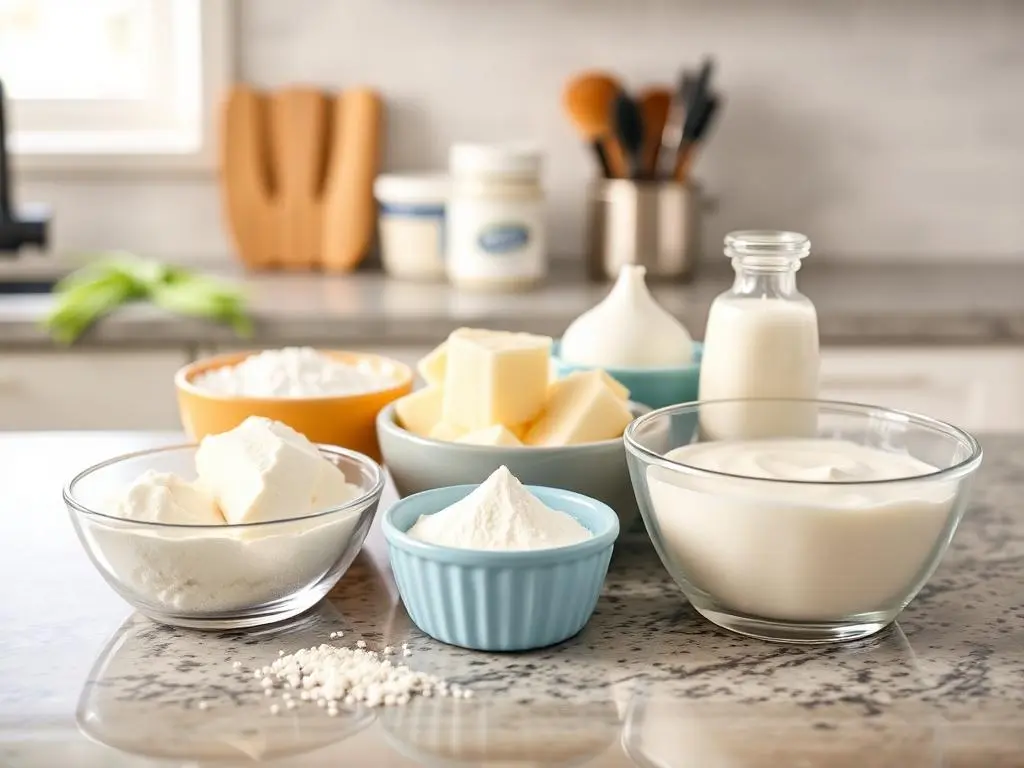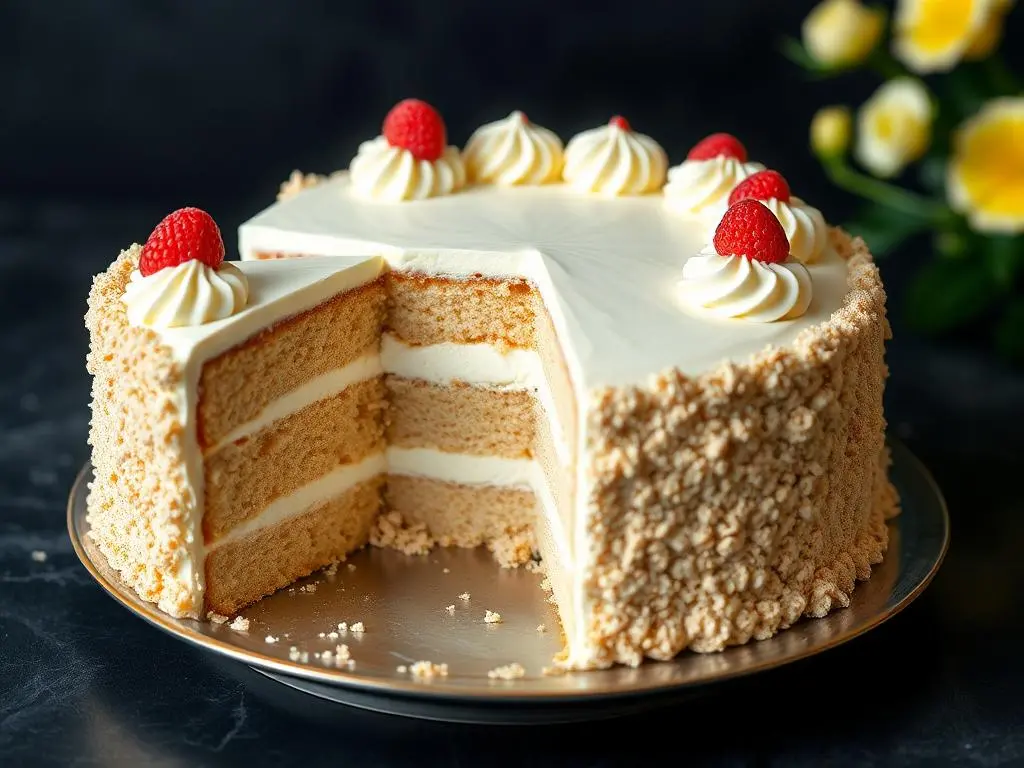Introduction
When it comes to baking, one of the most delightful components is the cream filling. Whether you’re whipping up a luscious pastry cream for a cake or a rich ganache for a tart, the thickness of your cream filling can make or break your dessert. But how do you thicken cream fillings to achieve that perfect consistency? In this article, we’ll explore various methods to thicken cream fillings, ensuring they’re not only delicious but also stable and visually appealing. From using starches and gelatin to incorporating dairy products, we’ll cover it all. So, let’s dive into the world of cream fillings and discover how to elevate your baking game!
Overview of Cream Fillings
Cream fillings are versatile and can be used in a variety of desserts, from cakes and pastries to pies and tarts. They add a rich, creamy texture that complements the other elements of a dessert. However, achieving the right thickness is crucial. A filling that’s too runny can lead to a soggy dessert, while one that’s too thick might be difficult to spread or pipe.
Importance of Thickness in Cream Fillings
The thickness of your cream filling plays a significant role in the overall success of your dessert. A well-thickened cream filling not only enhances the texture but also helps maintain the structure of your baked goods. For instance, if you’re making a layered cake, a thick filling will hold its shape between the layers, preventing any unwanted slippage. Additionally, the right thickness can enhance the flavor, making each bite a delightful experience.
Purpose of the Article
This article aims to provide you with a comprehensive guide on how to thicken cream fillings effectively. We’ll discuss various techniques, tips, and tricks to help you achieve the perfect consistency every time. Whether you’re a seasoned baker or just starting, this guide will equip you with the knowledge you need to create stunning desserts. So, let’s get started on our journey to mastering the art of thickening cream fillings!
Understanding Cream Fillings
To effectively thicken cream fillings, it’s essential to first understand what they are and the different types available. This knowledge will help you choose the right thickening method for your specific filling.
What Are Cream Fillings?
Cream fillings are mixtures that typically consist of cream, sugar, and flavorings. They can be used in a variety of desserts, providing a rich and creamy texture that enhances the overall flavor profile. The base of these fillings can vary, leading to different types of cream fillings, each with its unique characteristics.
Common Types of Cream Fillings
Pastry Cream
Pastry cream, or crème pâtissière, is a classic filling made from milk, sugar, eggs, and cornstarch. It’s often used in tarts, éclairs, and cakes. The key to a successful pastry cream is achieving the right thickness, which allows it to hold its shape when piped or spread.
Whipped Cream
Whipped cream is another popular filling, known for its light and airy texture. While it’s delicious on its own, it can sometimes be too soft for certain desserts. To thicken whipped cream, you can use stabilizers like gelatin or cornstarch, ensuring it maintains its shape when used in layered desserts.
Ganache
Ganache is a rich mixture of chocolate and cream, often used as a filling or frosting. The thickness of ganache can vary depending on the ratio of chocolate to cream. A thicker ganache is perfect for truffles or as a filling for cakes, while a thinner ganache can be used for drizzling or glazing.
Uses of Cream Fillings in Baking and Desserts
Cream fillings are incredibly versatile and can be used in a wide range of desserts. From filling pastries and cakes to serving as a base for mousses and trifles, the possibilities are endless. They can also be flavored with various ingredients, such as vanilla, chocolate, or fruit purees, allowing you to customize your desserts to suit any occasion.
Understanding the different types of cream fillings and their uses will help you determine the best thickening method for your specific recipe. Now that we’ve covered the basics, let’s explore why thickening cream fillings is so important in the next section.
Why Thicken Cream Fillings?
Thickening cream fillings is not just a matter of preference; it plays a crucial role in the overall quality and presentation of your desserts. Let’s delve into the reasons why achieving the right thickness is essential.
Texture and Stability
One of the primary reasons to thicken cream fillings is to enhance their texture and stability. A well-thickened filling provides a creamy, smooth mouthfeel that elevates the dessert experience. If your filling is too runny, it can lead to a messy presentation, especially in layered cakes or pastries. A thicker filling holds its shape better, ensuring that each slice or serving looks as good as it tastes.
Enhancing Flavor
Thickness can also impact the flavor perception of your cream filling. A thicker filling often has a more concentrated flavor, allowing the taste to shine through. For instance, a rich pastry cream can carry the flavors of vanilla or chocolate more effectively when it’s thickened properly. This concentration of flavor makes each bite more enjoyable and satisfying.
Presentation and Aesthetic Appeal
Let’s face it: we eat with our eyes first! The visual appeal of a dessert can significantly influence our desire to indulge. A thick cream filling that holds its shape adds to the overall aesthetic of your dessert. Whether it’s a beautifully piped whipped cream topping or a perfectly layered cake with stable pastry cream, the right thickness contributes to a polished and professional look.
Methods to Thicken Cream Fillings
Now that we’ve established why thickening cream fillings is essential, let’s dive into the various methods you can use to achieve that perfect consistency. Each technique has its unique benefits, so you can choose the one that best suits your recipe and preferences.
Using Starches
Starches are one of the most common thickening agents for cream fillings. They work by absorbing liquid and swelling, which helps create a thicker texture.
Cornstarch
Cornstarch is a popular choice for thickening pastry cream. To use it, mix cornstarch with a small amount of cold milk to create a slurry. Then, gradually add this mixture to your heated milk and sugar mixture while whisking continuously. This method ensures a smooth, lump-free filling. Remember to cook the mixture until it thickens and reaches a pudding-like consistency.
Arrowroot
Arrowroot is another excellent thickening agent, especially for those looking for a gluten-free option. It works similarly to cornstarch but creates a clearer, more glossy finish. To use arrowroot, mix it with cold liquid before adding it to your heated mixture. This method is particularly effective for fruit-based fillings, as it won’t break down when combined with acidic ingredients.
Tapioca Starch
Tapioca starch is a great alternative for thickening cream fillings, especially in recipes that require a chewy texture. It’s often used in pie fillings and can be added directly to the filling mixture. Just be cautious not to overheat it, as tapioca can become too thick if cooked for too long.
Gelatin and Agar-Agar
Gelatin and agar-agar are fantastic options for stabilizing cream fillings, particularly whipped cream.
How to Use Gelatin
To use gelatin, start by blooming it in cold water for about 5-10 minutes. Once it’s softened, gently heat it until it dissolves completely. Then, allow it to cool slightly before incorporating it into your whipped cream or pastry cream. This method will help your filling maintain its shape, making it perfect for layered desserts.
Vegan Alternatives: Agar-Agar
For those following a vegan diet, agar-agar is an excellent substitute for gelatin. Derived from seaweed, it works similarly but requires a different approach. Dissolve agar-agar in boiling water, then mix it into your filling. Keep in mind that agar-agar sets more firmly than gelatin, so adjust the amount based on your desired consistency.
Whipping Techniques
Sometimes, the method of incorporating air can also help thicken cream fillings.
Over-Whipping Cream
While it’s essential to whip cream to soft peaks for a light texture, over-whipping can lead to a thicker consistency. Just be cautious, as over-whipped cream can turn into butter if taken too far. Aim for a stable whipped cream that holds its shape without becoming grainy.
Incorporating Air for Volume
Incorporating air into your cream filling can also enhance its thickness. When whipping cream or mixing in other ingredients, use a whisk or electric mixer to introduce air. This technique not only thickens the filling but also adds a delightful lightness.
Adding Dairy Products
Incorporating additional dairy products can also help thicken cream fillings while enhancing flavor.
Cream Cheese
Cream cheese is a fantastic option for thickening cream fillings, especially in frostings and cheesecakes. Its rich texture adds creaminess while providing stability. Simply beat softened cream cheese into your filling until smooth and well combined.
Mascarpone
Mascarpone, an Italian cream cheese, is another excellent choice. It has a rich, velvety texture that can elevate your cream filling. Mix mascarpone into your whipped cream or pastry cream for a thicker, more luxurious filling.
Sour Cream
Sour cream can also be used to thicken cream fillings, adding a tangy flavor that complements sweet desserts. Incorporate it into your filling gradually, ensuring it blends smoothly without curdling.
Using Powdered Sugar
Powdered sugar, or confectioners’ sugar, can help thicken whipped cream fillings. It contains cornstarch, which acts as a stabilizer. When making whipped cream, add powdered sugar gradually while whipping to achieve a thicker consistency that holds its shape.
Chilling Techniques
Chilling your cream filling can also help thicken it, especially if you’re working with whipped cream or pastry cream.
Refrigeration
After preparing your cream filling, refrigerate it for at least 30 minutes. This cooling period allows the filling to set and thicken, enhancing its stability and texture. Chilling helps the ingredients meld together, resulting in a smoother and creamier consistency. Additionally, the cold temperature firms up the filling, making it easier to pipe or spread onto cakes and pastries. If you’re using gelatin, this step is especially crucial, as it needs time to activate and stabilize the filling. Just be sure to cover the filling with plastic wrap or a lid to prevent it from absorbing any odors from the fridge. This simple step can make a significant difference in the final outcome of your dessert!
Freezing
For an even thicker consistency, consider briefly freezing your cream filling. However, be cautious with this method, as freezing can alter the texture of some fillings. If you choose to freeze, allow the filling to thaw slightly before using it, ensuring it remains spreadable and creamy.
By employing these various methods, you can effectively thicken your cream fillings to achieve the desired texture and stability. Each technique has its unique advantages, so feel free to experiment and find the one that works best for your specific recipes. Now that you have a solid understanding of how to thicken cream fillings, let’s move on to some tips for perfecting your technique in the next section.
Tips for Perfectly Thickened Cream Fillings

Achieving the perfect thickness for your cream fillings can sometimes be a challenge, but with the right tips and techniques, you can master the art of thickening. Here are some essential tips to help you create delicious, stable cream fillings every time.
Choosing the Right Ingredients
The quality of your ingredients can significantly impact the thickness and flavor of your cream filling. Always opt for fresh, high-quality dairy products, as they will yield better results. For instance, using heavy cream instead of light cream will provide a richer texture and better stability when whipped. Additionally, choose the right thickening agents based on your recipe; for example, cornstarch works well for pastry cream, while gelatin is ideal for stabilizing whipped cream.
Temperature Control
Temperature plays a crucial role in the thickening process. When working with cream fillings, ensure that your ingredients are at the right temperature. For instance, when making whipped cream, start with cold heavy cream, as it whips better and holds its shape more effectively. Similarly, when using gelatin, make sure to bloom it in cold water before dissolving it in warm mixtures. This attention to temperature will help you achieve the desired consistency.
Timing and Technique
Timing is everything when it comes to thickening cream fillings. Be mindful of how long you cook your mixtures, especially when using starches. Overcooking can lead to a grainy texture, while undercooking may result in a runny filling. When whipping cream, keep an eye on the texture; stop whipping as soon as you reach soft or stiff peaks, depending on your recipe. Using a stand mixer or hand mixer can help you achieve consistent results, but be careful not to over-whip.
Avoiding Common Mistakes
To ensure your cream fillings turn out perfectly thickened, be aware of common mistakes that can hinder your efforts. Here are a few pitfalls to avoid:
- Not Whisking Enough: When using starches, make sure to whisk continuously to prevent lumps from forming. A smooth mixture is key to a successful filling.
- Using the Wrong Ratios: Pay attention to the ratios of your ingredients. Too much liquid can lead to a runny filling, while too much thickener can make it overly stiff.
- Ignoring the Setting Time: After preparing your cream filling, allow it to chill or set as needed. This step is crucial for achieving the right thickness and stability.
By following these tips, you’ll be well on your way to creating perfectly thickened cream fillings that enhance your desserts. Now that you have the tools and techniques to thicken your cream fillings.
When it comes to thickening cream fillings, there are a variety of techniques you can use, from adding cornstarch to incorporating gelatin for a firmer texture. For those working with cream cheese-based fillings, check out our guide on how to make cream cheese filling thicker or learn more about how to firm up cream cheese filling. Curious about the key ingredients in cheesecake fillings? Don’t miss our breakdown of what cheesecake filling is made from. These tips and tricks ensure your cream fillings are perfectly thick and ready for any dessert masterpiece.

FAQs
As you embark on your journey to thicken cream fillings, you may have some questions. Here are some frequently asked questions that can help clarify common concerns and provide additional insights into the thickening process.
1. What is the best way to thicken whipped cream?
The best way to thicken whipped cream is by using stabilizers like gelatin or cornstarch. For gelatin, bloom it in cold water, then dissolve it in warm cream before whipping. If you prefer a plant-based option, agar-agar can be used similarly. Additionally, incorporating powdered sugar while whipping can help stabilize the cream, giving it a thicker consistency.
2. Can I use flour to thicken cream fillings?
While flour can be used as a thickening agent, it’s not the best choice for cream fillings. Flour can create a gritty texture if not cooked properly. If you do choose to use flour, make sure to cook it in the liquid long enough to eliminate the raw taste, but this method is generally less preferred compared to cornstarch or other starches.
3. How long can I store thickened cream fillings?
Thickened cream fillings can typically be stored in the refrigerator for up to 3-5 days, depending on the ingredients used. Always cover the filling tightly to prevent it from absorbing odors or drying out. If you’ve used gelatin or other stabilizers, the filling may last longer, but it’s best to consume it within a few days for optimal freshness.
4. Is it possible to thin thickened cream fillings?
Yes, it is possible to thin thickened cream fillings if they become too stiff. You can add a small amount of milk or cream to the filling and gently mix until you reach the desired consistency. Be cautious not to add too much liquid at once, as this can lead to a runny filling.
5. What are some common recipes that use thickened cream fillings?
Thickened cream fillings are used in a variety of delicious recipes, including:
- Cream Puffs: Filled with pastry cream or whipped cream.
- Layered Cakes: Using stabilized whipped cream or pastry cream between layers.
- Tarts: Filled with rich ganache or fruit-flavored pastry cream.
- Mousses: Incorporating whipped cream for a light, airy texture.
- Cheesecakes: Using cream cheese and whipped cream for a thick, creamy filling.
These recipes showcase the versatility of thickened cream fillings and how they can elevate your desserts.
Conclusion
In this article, we’ve explored the fascinating world of cream fillings and the various methods to thicken them effectively. From understanding the different types of cream fillings to employing techniques like using starches, gelatin, and dairy products, you now have a
We discussed the importance of thickness in cream fillings, emphasizing how it affects texture, flavor, and presentation. You learned about common thickening agents such as cornstarch, gelatin, and even dairy products like cream cheese and mascarpone. Additionally, we provided practical tips for choosing the right ingredients, controlling temperature, and avoiding common mistakes that can hinder your thickening efforts.
Now that you’re equipped with this knowledge, don’t hesitate to experiment with different methods and ingredients. Baking is as much about creativity as it is about technique. Try incorporating various thickening agents into your favorite recipes, or mix and match to find the perfect combination that suits your taste.
Thickening cream fillings is a skill that can significantly enhance your baking repertoire. With practice and a little experimentation, you’ll be able to create stunning desserts that not only taste amazing but also look professional. So, roll up your sleeves, gather your ingredients, and start thickening those cream fillings! Happy baking!

